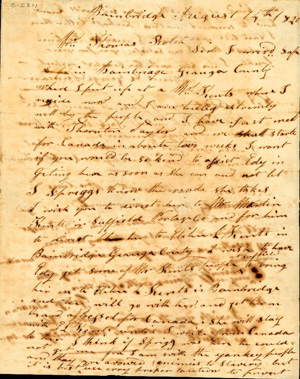Canton, Ohio, Embraces The Disappearing Man

This letter was written to Thomas Rotch from George Duncan, a slave he had helped escape. To read what the letter says, go to http://www.springhillhistorichome.org/?page_id=534.
There’s something about Ohio.
Cincinnati, Ohio, is home of the National Underground Railroad Freedom Center, where I first discovered the story of Henry “Box” Brown and his incredible escape from slavery. Now, Canton, Ohio, has selected The Disappearing Man, my novel about Henry Brown, as its choice for the 2011 One Book, One Community Program. This fall, the city of Canton will host several days of events surrounding The Disappearing Man and the Underground Railroad.
“The Underground Railroad in Ohio was an amazingly efficient and well organized operation,” according to a 1996 article in Ohio State Parks Magazine. “In all, nearly three thousand miles of routes crisscrossed the state, most bound in a northeasterly direction, and at least 23 points of entry were established along the Ohio River.”
The Ohio River even played a role in one of the legends about the origins of the term “underground railroad.” According to this legend, a runaway slave named Tice Davids swam across the Ohio River with his owner in pursuit by boat. When the owner failed to catch his escaped slave on the other side of the river, he supposedly said that Tice had “gone off on an underground railroad.”
Escapes across the Ohio River also inspired Harriet Beecher Stowe to write Uncle Tom’s Cabin, the anti-slavery novel that became the second most popular book behind the Bible in the United States during the nineteenth century. Stowe lived in Cincinnati from 1830 to 1850, yet another Ohio connection in the abolitionist movement.
The Canton area features a couple of stations on the underground railroad, where slaves were safely harbored on their way to Canada. One of them is Spring Hill, the home of Quakers Thomas and Charity Rotch. Invaluable Friends, a book about the Rotches, said that no slave was ever caught at Spring Hill, although there was one close call when a slave catcher named DeCamp showed up, demanding that an escaped woman and her children be handed over to him. When the Rotch’s farmhands encircled DeCamp, the slave catcher retreated and never came back.
“For the safety of all involved, few records were kept of the numbers and identities of persons who reached freedom along the railroad,” says Ohio State Parks Magazine, “but it is estimated that at least 40,000 passed through Ohio.”
So hats off to Ohio.
Doug Peterson
